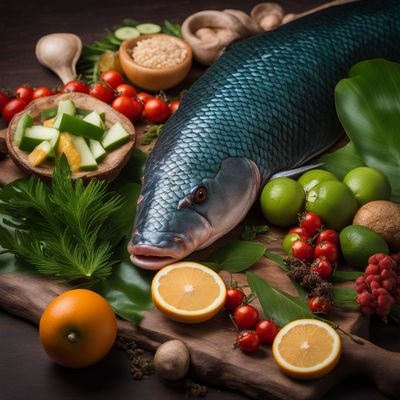
Ingredient
Climbing perch
The Aquatic Acrobat: Exploring the World of Climbing Perch
Climbing perch is a freshwater fish that possesses a distinctive ability to breathe air and even climb trees using its specialized gill chambers. With a slender body covered in scales, it features a silver-gray coloration and a slightly flattened shape. The flesh of climbing perch is firm and white, offering a delicate yet meaty texture. Its flavor is mild and slightly sweet, with hints of earthiness and a subtle brininess.
Origins and history
Native to Southeast Asia, climbing perch has been an integral part of the region's cuisine for centuries. It is particularly popular in countries like Thailand, Malaysia, and Indonesia, where it is often found in traditional dishes. The fish's unique ability to survive in oxygen-depleted waters and its climbing behavior have fascinated locals and researchers alike, contributing to its cultural and scientific significance.
Nutritional information
Climbing perch is a nutritious ingredient, rich in protein, omega-3 fatty acids, and essential minerals such as calcium, phosphorus, and iron. It is also relatively low in calories, making it a healthy choice for those seeking a balanced diet.
Allergens
There are no known allergens associated with climbing perch.
How to select
When selecting climbing perch, look for fish that have clear, bright eyes, shiny scales, and a fresh, mild aroma. The flesh should be firm to the touch and free from any sliminess or discoloration. If purchasing from a fish market, ensure that the fish is displayed on ice to maintain its freshness.
Storage recommendations
To maintain the freshness and quality of climbing perch, it should be stored in a refrigerator at a temperature of around 32°F to 39°F (0°C to 4°C). It is advisable to wrap the fish in moisture-proof paper or place it in an airtight container to prevent any odor transfer.
How to produce
Climbing perch can be challenging to produce for amateurs, as it requires specific conditions and expertise in aquaculture. It is best left to professional fish farmers who can provide the necessary environment and care for the fish.
Preparation tips
Climbing perch can be prepared in various ways, including grilling, frying, or steaming. Before cooking, it is recommended to clean the fish thoroughly, removing any scales, guts, and gills. Marinating the fish with herbs, spices, and citrus juices can enhance its flavor. When grilling or frying, ensure that the fish is cooked until the flesh becomes opaque and flakes easily with a fork.
Culinary uses
Climbing perch is commonly used in Southeast Asian cuisine, where it is featured in dishes such as fish curry, stir-fries, and soups. Its firm texture makes it suitable for grilling or frying, while its mild flavor allows it to absorb the flavors of various spices and sauces.
Availability
Climbing perch is commonly available and cultivated in Southeast Asian countries such as Thailand, Malaysia, and Indonesia.
More ingredients from this category » Browse all

Perch, golden
The Golden Catch: Perch

Arapaima
The Mighty Arapaima: A Culinary Treasure from the Amazon

Asian swamp eel
The Aquatic Delicacy: Unveiling the Asian Swamp Eel

Silver perch
The Delicate Delight: Silver Perch

African bonytongue
Exploring the African Bonytongue: A Delicacy from the Waters

Cod, murray
The Mighty Murray Cod: A Delicate Delight

Snakeheads(=Murrels)
The Mighty Murrels

Largemouth black bass
The Prized Catch: Largemouth Black Bass

Gudgeons
Delicate Delights from the Water

Dagaas
The Exotic Aroma of Dagaas

Bluegill sunfish, or bluegill bream
The Freshwater Delight: Bluegill Sunfish

Catfishes (freshwater)
The Delicate Delight: Freshwater Catfish